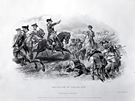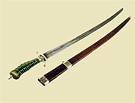 |

4. Sword
|
 |


4. SWORD
Symbolic:
 |
 |

Engraving of George Washington by James Heath after
Gilbert Stuart’s
Lansdowne painting
National Portrait Gallery, Smithsonian Institution
|
The sheathed sword, held in Washington’s left hand, is ceremonial. Although a sword with a suit (rather than with a uniform) was going out of style, it was “the grand distinguishing mark of a fine Gentleman.” It is also a symbolic reference to Washington as head of state.
 |
 |

George Washington Taking the Salute at Trenton, by John Faed, oil on canvas,
circa 1899
The Warner Collection
of Gulf States
Paper Corporation,
Tuscaloosa, Alabama
|
In portraits of Washington in military uniform, the sword is a natural part of the uniform. And for General Washington, who often wielded a sword in battle, it is a weapon of war.
Biographic:
 |
 |

Washington as Captain in the French and Indian War by Junius Brutus Stearns, oil on canvas, circa 1849-1856
Virginia Museum of
Fine Arts
|
Washington’s military career began early. At 20, he was already a major in the Virginia militia. In 1752, on his first major military operation, he told French troops in the Allegheny River Valley that they had trespassed on land claimed by the British colony of Virginia. The French said they planned to stay—in a direct challenge to the British; however, no armed clash occurred. A year later, as a colonel, in what is now western Pennsylvania he subdued a small French force—and later was defeated by more French troops. The incidents were the first skirmishes of what became the French and Indian War.
 |
 |

George Washington’s Tent
National Museum of American History, Smithsonian Institution, Behring Center
|
In 1775, fellow delegates to the Second Continental Congress selected Washington as commander-in-chief of the Continental Army. He held that post throughout the Revolutionary War. General Washington transformed ragtag groups of men into a victorious army. British Red Coats relied on European-style, parade ground maneuvering. Washington countered with quick, small-unit skirmishes-a tactic that would later be called guerrilla warfare. Washington lost several battles, but he never strayed from his strategy: prevent the British from linking forces in the north with those in the south. He had two basic rules:“Avoid a general Action” and never “put anything at Risque.”
 |
 |

Washington at Monmouth by G. R. Hall,
engraving, 1858
National Portrait Gallery, Smithsonian Institution
|
Washington was a warrior. From 1755 to 1758, Washington commanded troops on the French-British frontier. “I had four Bullets through my Coat, and two Horses shot under me,” he said after a battle in the French and Indian War. In another, he rode between two columns of panicky soldiers firing at each other instead of at the enemy. With his sword, he levered up the muskets, saving lives as he risked his own.
 |
 |

George Washington’s sword used during the Revolutionary War
National Museum of American History, Smithsonian Institution, Behring Center
|
Washington bequeathed his swords to his nephews, telling them not to unsheathe them “for the purpose of shedding blood, except it be for self defence, or in defence of their Country and its rights; and in the latter case, to keep them unsheathed, and prefer falling with them in their hands to the relinquishment thereof.”
Artistic:
 |
 |

George Washington on Horseback During the Battle of Princeton, by John Trumbull
Library of Congress
|
The sword in the portrait apparently belonged to the Comte de Noailles, who had fought alongside Washington during the Revolutionary War. According to Jane Stuart, the artist’s daughter, Noailles gave Stuart a “superb silver-mounted rapier” so that Stuart could include a sword in the painting. If Noailles’ sword is the one in the painting, it has long since disappeared. Stuart’s daughter said that, although her father highly valued the sword, “when the family treasury was low, Mrs. Stuart, who never liked to see the sword in the house, had the silver mounting converted into tea-spoons; which spoons were subsequently stolen.”
|




